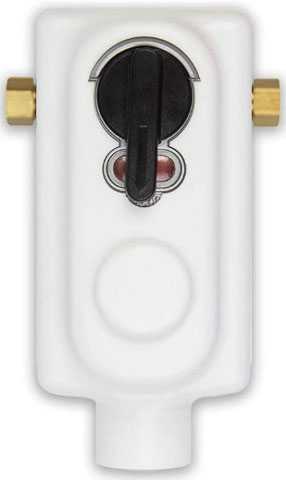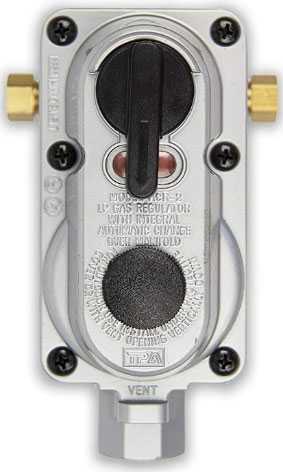alliance RV Valor 2021 Traveling with Propane User Manual
Traveling with Propane
Turning the propane off when traveling is always safer, it reduces the risk of a gas leak from a line or connection working loose. Some states have laws against traveling with propane on. Make sure you are familiar with those laws and regulations in the area you are traveling.
WARNING
MAKE SURE ALL PROPANE TANK FASTENERS ARE SECURED BEFORE TRAVELING.
LP Automatic Changeover Regulator
To regulate the propane pressure, an RV is equipped with a two‐stage regulator with automatic changeover. With the first stage of the regulator, the fuel coming from the tank is reduced by venting from the high pressure the LP is compressed under for storage and takes it down to 10 to 15 psi. In the second stage, the pressure is reduced again by further venting down to 11” water column which is the pressure safe for the appliances that the propane system powers. Always make sure that the vents are clean and unobstructed.
LP Automatic Changeover Regulator

This regulator allows for the removal of empty cylinders for refill without interrupting the propane supply and will automatically switch from the supplying tank to the reserve tank when empty.
WARNING
PROPANE CONNECTIONS SHOULD BE CHECKED PERIODICALLY AS VIBRATIONS FROM TRAVEL MAY CAUSE THEM TO LOOSEN. FAILURE TO CHECK THESE CONNECTIONS COULD LEAD TO A PROPANE LEAK. A LEAK CAN CAUSE A FIRE OR EXPLOSION.

alliance RV Valor 2021 Top Accessories
[amalinkspro_table id=”32452″ new-window=”on” nofollow=”on” addtocart=”off” /]
Propane System Maintenance
Routinely visually inspect your propane cylinders, mounting hardware, supply lines, and connection points for wear, rust, kinks or damage. The propane system should be serviced by a qualified technician immediately upon an issue being identified. Never paint propane cylinders, valves or mounting hardware. Your RVs propane system should be inspected by a certified professional at least once a year. Never attempt to repair any propane-related component yourself. Always make sure your RVs fire extinguisher, CO, gas, and smoke detectors are in working order. Do this by regularly testing your alarms and safety items. An alarm or extinguisher that is not working should be replaced immediately.
WARNING
NEVER ATTEMPT TO REPAIR ANY PROPANE-RELATED COMPONENT. ENSURE THAT ALL ALARMS, DETECTORS, AND EXTINGUISHERS ARE IN GOOD WORKING ORDER.
Filling Your Propane Tanks
Your Alliance RV uses DOT cylinders. These cylinders can be removed and taken to a propane dealer for refilling. A propane tank can only be filled to 80% of its total capacity. The remaining 20% is for expansion that takes place when subjected to heat. If a tank is filled to 80% when it is cold outside, that same tank may be at 90% on a much warmer day. Always ensure that the tank is filled to the required limit only.
WARNING
NEVER FILL A PROPANE TANK OVER 80% OF ITS CAPACITY. AN OVERFILLED TANK COULD ALLOW LIQUID PROPANE TO ENTER THE SYSTEM WHICH IS DESIGNED FOR VAPOR AND CREATE A VERY HAZARDOUS CONDITION.
Installing Propane Cylinders
Anytime a propane tank is removed for servicing or filling and re‐installed on the RV, ensure that the fittings are all tight and the main shutoffs on the LP tanks are in the off position and that the strap that secures the tank is in place. A quick visual inspection of the LP system should be performed at any time tanks are removed.
Cooking with Propane Gas
In an RV most stovetops and ovens run on propane. A properly ventilated RV is very important when cooking. Open a window or roof vent and turn your range hood fan on. Never use your stove or oven for space heat and never use outdoor fuel‐burning equipment inside the RV.
WARNING
- DO NOT ATTEMPT TO USE WATER TO PUT OUT A GREASE FIRE. WATER CAN SPREAD SOME TYPES OF FIRE AN ELECTROCUTION IS POSSIBLE WITH AN ELECTRICAL FIRE.
- NEVER ALLOW GREASE TO COLLECT ON OR AROUND THE STOVE. CLEAN SPILLS UP IMMEDIATELY. IN AN RV, THE AMOUNT OF OXYGEN SUPPLY IS LIMITED DUE TO ITS SIZE.
- PROPER VENTILATION DURING COOKING WILL HELP AVOID DANGEROUS SITUATIONS.
FUEL STATION
Fuel Station Overview
There is a standard fuel station on your Valor FW with two separate (gasoline-only) tanks. One tank supplies the pump/nozzle and one tank supplies the generator.
- Fuel Fill Caps
- Fuel Station Control Panel
- Fuel Pump/Nozzle Compartment
The fuel station is located on the exterior, off‐door side, of the RV BEFORE OPERATING: Please read and follow all safety information in the Fuel Station section of this manual. Failure to comply could result in death or serious injury. If you need further assistance, consult with your dealer or Alliance RV Customer Service.
Exhaust Fumes
WARNING
THERE IS A POTENTIAL FOR EXHAUST FUMES TO FILTER BACK INTO YOUR RV IF A TOW VEHICLE OR GENERATOR ENGINE IS RUNNING NEARBY.
THE BEST PROTECTION AGAINST CARBON MONOXIDE ENTRY INTO THE RV IS A PROPERLY MAINTAINED VENTILATION SYSTEM AND AN ACTIVE CARBON MONOXIDE DETECTOR. TO ALLOW FOR PROPER OPERATION OF THE VENTILATION SYSTEM, KEEP THE VENTILATION INLET GRILL(S) CLEAR OF SNOW, LEAVES OR OTHER OBSTRUCTIONS.
Avoid inhaling any exhaust gases. They contain carbon monoxide, which is a potentially toxic gas that is colorless and odorless.
- ALWAYS shut OFF the engine while refueling your vehicle or generator.
- DO NOT run any combustion engine in confined areas, such as a closed garage, or any longer than needed to move in or out of your RV’s garage.
- If a vehicle or generator engine is running nearby, RV windows should be closed to avoid drawing dangerous exhaust gases into the RV.
- If you suspect that exhaust fumes are entering the RV, determine the cause and remedy as soon as possible.
Fuel Filler Cap
WARNING
DO NOT REPLACE THE FUEL FILLER CAP WITH ONE OF A DIFFERENT TYPE. IF REPLACING THE FUEL CAP(S) IS REQUIRED, IT MUST BE REPLACED WITH A CAP DESIGNED SPECIFICALLY FOR THIS APPLICATION. FAILURE TO DO SO MAY RESULT IN IMPROPER VENT PRESSURE AND/0R VACUUM LEADING TO SERIOUS FUEL SYSTEM AND OTHER DAMAGE. WORKING WITH FUEL CAN BE DANGEROUS. SERIOUS INJURY OR DEATH COULD RESULT FROM IMPROPER HANDLING OF THE GENERATOR, FUEL STATION AND FUEL.
Open the Fuel Filler Cap Slowly: If the fuel filler cap is opened too quickly, fuel can spray out on you. This is more likely to happen in hot weather and/or if your tank is nearly full.
- To open: Remove the fuel filler cap by slowly turning it counterclockwise and waiting for any “hiss” noise to stop. Then unscrew the cap all the way.
- To close: Securely turn the cap clockwise until you hear clicking sounds. If you need to replace the fuel tank filler cap, use only a cap specified for your RV.
- AUTOMOTIVE FUELS CAN CAUSE SERIOUS INJURY OR DEATH IF MISUSED OR MIS‐HANDLED. IF YOU HAVE FURTHER QUESTIONS CONSULT YOUR DEALER OR ALLIANCE CUSTOMER SERVICE FOR ASSISTANCE. WHILE REFUELING, ALWAYS SHUT OFF THE ENGINE OF THE VEHICLE OR EQUIPMENT.
- DO NOT STORE OR BRING FUEL OR OTHER FLAMMABLE LIQUIDS INSIDE THE RV BECAUSE A FIRE OR EXPLOSION MAY RESULT.
- EXTINGUISH ALL SMOKING MATERIALS AND ANY OPEN FLAMES BEFORE REFUELING.
- DO NOT OVERFILL THE FUEL TANK(S). THE PRESSURE IN AN OVERFILLED FUEL TANK MAY CAUSE LEAKAGE AND LEAD TO FUEL SPRAY AND/OR FIRE. FUEL SPILLS REPRESENT A SERIOUS FIRE HAZARD AND SHOULD BE CLEANED UP IMMEDIATELY.
- NEVER RESTART AN ENGINE OR RE‐LIGHT ANY PILOT LIGHTS WHILE RAW FUEL IS PRESENT.
- THE FUEL TANKS ARE SPECIFICALLY MADE FOR UNLEADED GASOLINE. ALWAYS USE CLEAN, FRESH UNLEADED FUEL NOT CONTAINING A BLEND OF MORE THAN 15%ETHANOL.
- FAILURE TO COMPLY COULD RESULT IN FIRE, DEATH OR SERIOUS INJURY.
Reference Links
View Full User Guide: alliance RV Valor 2021 User Manual
Download Manuals: https://dev.alliancerv.com/owners-manuals


